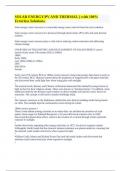Exam (elaborations)
SOLAR ENERGY/PV AND THERMAL || with 100% Errorless Solutions.
- Course
- Institution
Solar energy correct answers is a renewable energy source derived from the sun's radiation. Solar energy correct answers It is harnessed through photovoltaic (PV) cells and solar thermal systems. Solar energy correct answers plays a vital role in reducing carbon emissions and addressing clima...
[Show more]



